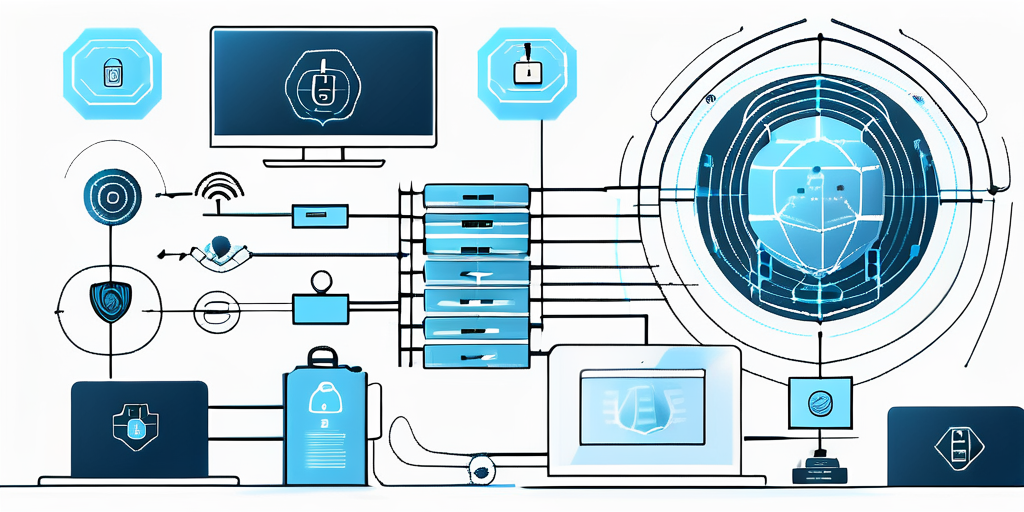Transport Layer Security (TLS) is an essential protocol for securing data transmission over the internet. TLSv1.3 is the latest iteration of this protocol, bringing significant improvements in security, speed, and performance. In this article, we will delve into the basics of TLSv1.3, explore its technical aspects, discuss the benefits of using it, and address the challenges in implementing it. We will also explore the future developments of TLSv1.3 and its role in ensuring internet security.
Understanding the Basics of TLSv1.3
TLSv1.3 represents a significant advancement in the TLS protocol. To understand its importance, it is crucial to grasp the evolution of TLS and the key features that distinguish TLSv1.3 from its predecessors.

The Evolution of TLS
Introduced as the successor to Secure Sockets Layer (SSL), TLS has undergone several versions, with each version introducing improved security measures and fixed vulnerabilities. TLSv1.3 builds upon the foundation laid by TLSv1.2 and addresses its limitations.
One of the major improvements in TLSv1.3 is the removal of outdated and insecure cryptographic primitives. These outdated primitives were susceptible to attacks and vulnerabilities, which compromised the security of the TLS protocol. By eliminating them, TLSv1.3 ensures that only the most secure and robust cryptographic algorithms are used, providing a stronger defense against potential threats.
Another significant enhancement in TLSv1.3 is the implementation of improved encryption algorithms. These algorithms offer stronger and more efficient encryption, making it harder for attackers to decrypt intercepted data. With TLSv1.3, the encryption process is more secure and reliable, ensuring the confidentiality of sensitive information transmitted over the Internet.
Key Features of TLSv1.3
TLSv1.3 boasts several noteworthy features that contribute to its enhanced security. These include:
- Improved encryption algorithms: TLSv1.3 utilizes state-of-the-art encryption algorithms, such as ChaCha20-Poly1305 and AES-GCM, which provide stronger and more efficient encryption.
- Elimination of obsolete cryptographic primitives: TLSv1.3 removes outdated and insecure cryptographic primitives, ensuring that only the most secure algorithms are used.
- Enhanced forward secrecy: TLSv1.3 enhances forward secrecy by implementing the Diffie-Hellman key exchange algorithm with elliptic curve cryptography (ECDHE), which ensures that even if the server’s private key is compromised in the future, past communications remain secure.
- Reduced round-trips during the initial handshake: TLSv1.3 reduces the number of round-trips required during the initial handshake, resulting in faster and more efficient connections.
- Support for more secure cipher suites: TLSv1.3 supports a limited number of cipher suites that have been carefully selected for their security and performance characteristics.
The Importance of TLSv1.3 in Internet Security
With the ever-growing reliance on the internet for various activities, maintaining the security and integrity of data transmission has become paramount. TLSv1.3 plays a crucial role in ensuring the confidentiality, authenticity, and integrity of data exchanged on the internet.
By implementing the latest security measures and addressing the vulnerabilities present in previous versions, TLSv1.3 provides a robust and secure framework for secure communication over the internet. It ensures that sensitive information, such as passwords, credit card details, and personal data, remains protected from unauthorized access and interception.
Furthermore, TLSv1.3’s enhanced forward secrecy ensures that even if an attacker gains access to the server’s private key in the future, they cannot decrypt past communications. This feature adds an additional layer of security, safeguarding the privacy of past interactions.
In conclusion, TLSv1.3 represents a significant step forward in internet security. Its improved encryption algorithms, elimination of obsolete cryptographic primitives, enhanced forward secrecy, reduced round-trips during the initial handshake, and support for more secure cipher suites make it a crucial component in securing data transmission over the internet.
The Technical Aspects of TLSv1.3
Now that we have a grasp of the fundamentals, let’s explore the technical aspects that underpin TLSv1.3.
TLSv1.3, the latest version of the Transport Layer Security (TLS) protocol, introduces a streamlined and efficient protocol that simplifies and improves security without sacrificing compatibility. This new protocol is designed to enhance the overall security of communication over the internet.
The primary objective of TLSv1.3 is to provide a secure and reliable channel for data transmission between clients and servers. To achieve this, the protocol incorporates several key features and optimizations.
The Protocol of TLSv1.3
TLSv1.3 introduces a streamlined protocol that reduces complexity and improves security. The new protocol aims to minimize the attack surface by removing outdated and vulnerable features present in previous versions.
One of the significant improvements in TLSv1.3 is the elimination of unnecessary round-trips during the handshake process. In previous versions, multiple round-trips were required to negotiate the connection parameters, which added latency and increased the risk of potential attacks. TLSv1.3 reduces the number of round-trips, resulting in faster and more secure connections.
Additionally, TLSv1.3 incorporates modern cryptographic algorithms and key exchange mechanisms to ensure the confidentiality, integrity, and authenticity of data exchanged between the client and server. These algorithms provide robust protection against eavesdropping, tampering, and other malicious activities.
The Handshake Process in TLSv1.3
The handshake process is a fundamental aspect of establishing a secure TLS connection. In TLSv1.3, the handshake process has been optimized for efficiency and security.
The TLSv1.3 handshake process involves multiple steps, including:
- Client Hello: The client initiates the handshake process by sending a Client Hello message to the server. This message includes information about the client’s supported cipher suites, key exchange algorithms, and other parameters.
- Server Hello: Upon receiving the Client Hello message, the server responds with a Server Hello message. This message contains the selected cipher suite, key exchange algorithm, and other parameters agreed upon by both the client and server.
- Key Exchange: The client and server perform a key exchange to establish a shared secret key. This shared key is used for encrypting and decrypting data during the TLS session.
- Authentication: The client and server authenticate each other’s identities to ensure mutual trust. This authentication process involves the exchange of digital certificates, which are used to verify the authenticity of the client and server.
By optimizing the handshake process, TLSv1.3 reduces the latency and improves the overall performance of secure connections. The streamlined handshake process also enhances security by minimizing the exposure of sensitive information during the negotiation phase.
Encryption and Decryption in TLSv1.3
One of the primary objectives of TLSv1.3 is to ensure robust encryption and decryption of data exchanged between the client and server.
TLSv1.3 employs state-of-the-art encryption algorithms, such as the Advanced Encryption Standard (AES) and ChaCha20, to protect data against eavesdropping and tampering. These encryption algorithms provide strong cryptographic security and are widely recognized as secure and efficient.
Furthermore, TLSv1.3 supports perfect forward secrecy (PFS), which ensures that even if the long-term private key of a server is compromised, previously recorded encrypted communications remain secure. This is achieved by generating a unique session key for each TLS session, which is discarded after the session ends.
The decryption process in TLSv1.3 is performed by the recipient using the shared secret key established during the handshake process. The recipient applies the appropriate decryption algorithm to recover the original plaintext data.
By employing robust encryption and decryption mechanisms, TLSv1.3 ensures the confidentiality and integrity of data transmitted over the internet. This level of security is crucial in protecting sensitive information, such as passwords, financial transactions, and personal data, from unauthorized access and manipulation.
The Benefits of Using TLSv1.3
TLSv1.3 brings several advantages over its predecessors, making it the preferred choice for securing online communications.

Regarding online security, staying one step ahead of cyber threats is crucial. TLSv1.3 takes a proactive approach by eliminating weak cryptographic primitives and outdated features. By doing so, it enhances the overall security posture of internet communications, providing a robust defense against sophisticated cyber attacks.
One of the key strengths of TLSv1.3 lies in its focus on strong encryption algorithms. These algorithms ensure that data transmitted over the internet remains confidential and protected from prying eyes. Additionally, TLSv1.3 incorporates enhanced forward secrecy, which means that even if an attacker manages to compromise a session key, they won’t be able to decrypt past or future communications.
Improved Security with TLSv1.3
By eliminating weak cryptographic primitives and outdated features, TLSv1.3 enhances the overall security posture of Internet communications. The protocol’s focus on strong encryption algorithms and enhanced forward secrecy helps protect against sophisticated cyber threats.
But security is not the only area where TLSv1.3 shines. It also brings significant speed and performance enhancements to secure connections. In today’s fast-paced digital world, where every millisecond counts, TLSv1.3 incorporates optimizations that reduce latency and improve overall performance.
One of the ways TLSv1.3 achieves this is by minimizing round-trips. In previous versions of TLS, multiple round-trips were required to establish a secure connection, leading to increased latency. TLSv1.3 streamlines this process by reducing the number of round-trips required, resulting in faster and more responsive communication between clients and servers.
Speed and Performance Enhancements in TLSv1.3
TLSv1.3 incorporates optimizations that reduce the latency and improve the overall performance of secure connections. TLSv1.3 facilitates faster and more responsive communication between clients and servers by minimizing round-trips and employing more efficient algorithms.
Moreover, TLSv1.3 employs more efficient key exchange and authentication algorithms, further contributing to its improved performance. These algorithms have been carefully designed to balance security and speed, ensuring that secure connections can be established quickly and efficiently.
While security and performance are undoubtedly important, compatibility and interoperability with legacy systems and older TLS versions cannot be overlooked. TLSv1.3 considers this, aiming to strike a delicate balance between security and compatibility.
Compatibility and Interoperability of TLSv1.3
Despite the significant improvements introduced in TLSv1.3, compatibility with legacy systems and interoperability with older TLS versions remain important considerations. TLSv1.3 balances security and compatibility, ensuring smooth organizational transition and minimizing disruptions.
Organizations that rely on older TLS versions or have legacy systems in place can still benefit from TLSv1.3. The protocol is designed to be backward compatible, allowing seamless integration with existing infrastructure. This means that organizations can upgrade to TLSv1.3 without needing a complete overhaul of their systems, reducing the potential for disruptions and ensuring a smooth transition.
In conclusion, TLSv1.3 offers a range of benefits that make it the preferred choice for securing online communications. From improved security and enhanced performance to compatibility and interoperability, TLSv1.3 provides a comprehensive solution for organizations looking to protect their data and maintain a secure online presence.
Challenges and Solutions in Implementing TLSv1.3
While TLSv1.3 offers numerous benefits, implementing it can present certain challenges. Let’s explore some common implementation issues and the solutions to overcome them.
Common Implementation Issues
Adopting TLSv1.3 involves changing existing systems, which can lead to compatibility issues and potential disruptions. Organizations must carefully plan their implementation strategy, considering factors such as legacy system dependencies and vendor support.
One common challenge organizations face when implementing TLSv1.3 is the compatibility issue with legacy systems. Many organizations have systems that were built using older versions of TLS, such as TLSv1.1 or TLSv1.2. Upgrading to TLSv1.3 may require significant changes to these systems, which can be time-consuming and costly.
Another challenge is ensuring compatibility with third-party vendors. Organizations often rely on various software and hardware solutions provided by different vendors. It is crucial to ensure that these vendors support TLSv1.3 and that their products are compatible with the new protocol. This may require coordination and collaboration with vendors to update their software or hardware.
Overcoming Compatibility Challenges
To ensure a smooth transition, it is vital to address compatibility challenges when moving to TLSv1.3. This may involve upgrading or replacing outdated software, performing thorough testing, and collaborating with vendors to ensure compatibility across systems.
One solution to overcome compatibility challenges is to conduct a thorough assessment of the existing systems and identify any potential compatibility issues. This can be done by reviewing system documentation, conducting compatibility tests, and engaging with vendors to understand their support for TLSv1.3.
If compatibility issues are identified, organizations may need to upgrade or replace outdated software or hardware components. This can involve working closely with vendors to obtain the latest versions or seeking alternative solutions that are compatible with TLSv1.3.
Additionally, organizations can perform extensive testing to ensure that the new TLSv1.3 implementation works seamlessly with existing systems. This can involve setting up test environments, simulating real-world scenarios, and conducting performance tests to identify and resolve any compatibility issues.
Ensuring Optimal Performance with TLSv1.3
While TLSv1.3 is designed to improve performance, suboptimal configurations or network conditions can impact its efficiency. Organizations should implement best practices, such as ensuring proper cipher suite selection, enabling session resumption, and optimizing network configurations to maximize the benefits of TLSv1.3.
Cipher suite selection plays a crucial role in optimizing the performance of TLSv1.3. By choosing the appropriate cipher suites, organizations can ensure a balance between security and performance. It is important to consider factors such as encryption strength, key exchange algorithms, and forward secrecy when selecting cipher suites.
Enabling session resumption can also improve performance by reducing the time and resources required to establish a new TLS connection. Session resumption allows clients and servers to reuse previously established cryptographic parameters, reducing the computational overhead and improving response times.
Optimizing network configurations, such as reducing latency and optimizing bandwidth, can further enhance the performance of TLSv1.3. This can involve implementing techniques such as content delivery networks (CDNs), load balancing, and network acceleration technologies to ensure efficient data transmission.
In conclusion, implementing TLSv1.3 may present challenges, but with careful planning, collaboration with vendors, and adherence to best practices, organizations can overcome these challenges and enjoy the benefits of improved security and performance.
The Future of TLSv1.3
Looking ahead, TLSv1.3 is poised for further advancements to address evolving security threats and technological advancements.

Predicted Developments in TLSv1.3
As security threats continue to evolve, TLSv1.3 will adapt and introduce new features to stay ahead. We can expect ongoing improvements in encryption algorithms, certificate management processes, and increased support for new platforms and technologies.
One area of development in TLSv1.3 is the enhancement of encryption algorithms. As cybercriminals become more sophisticated, it is crucial to continually strengthen the encryption used in TLS. Future versions of TLSv1.3 may introduce even more robust encryption algorithms that can withstand advanced attacks and ensure the confidentiality and integrity of transmitted data.
Certificate management is another aspect that will see improvements in TLSv1.3. Simplifying the process of obtaining and managing digital certificates will make it easier for organizations to deploy TLSv1.3 securely. Automation and streamlined workflows will reduce the administrative burden associated with certificate management, ensuring that organizations can easily maintain the security of their communication channels.
Moreover, TLSv1.3 will expand its support for new platforms and technologies. With the proliferation of Internet of Things (IoT) devices and the increasing adoption of cloud computing, TLSv1.3 will need to adapt to secure these emerging technologies. Future versions may incorporate specific features and optimizations tailored to IoT and cloud environments, ensuring that TLSv1.3 remains a reliable and robust security protocol across various platforms.
The Role of TLSv1.3 in Future Internet Security
TLSv1.3 will continue to serve as a critical component in securing internet communications. Its strong security foundation and emphasis on performance make it an ideal choice for protecting sensitive data in an increasingly connected world.
One of the key advantages of TLSv1.3 is its improved security posture. By eliminating older, less secure cryptographic algorithms and implementing stronger encryption protocols, TLSv1.3 provides a higher level of protection against eavesdropping, tampering, and other malicious activities. This enhanced security ensures that sensitive information, such as financial transactions and personal data, remains confidential and secure during transmission.
Furthermore, TLSv1.3’s focus on performance optimization is crucial in today’s fast-paced digital landscape. By reducing the number of round trips required for establishing a secure connection, TLSv1.3 minimizes latency and improves the overall user experience. This performance boost is particularly important for resource-intensive applications, such as video streaming and online gaming, where even slight delays can significantly impact user satisfaction.
Preparing for Future Updates and Changes
Organizations must remain vigilant about emerging updates and changes to TLSv1.3 and ensure their systems are up to date. Staying informed, actively participating in industry discussions, and engaging with security experts can help organizations proactively adapt to future developments.
Regularly updating TLSv1.3 implementations is crucial to benefit from the latest security enhancements and bug fixes. Organizations should establish a robust patch management process to promptly apply updates and ensure that their systems remain protected against emerging threats.
Additionally, staying informed about industry best practices and participating in relevant discussions can provide valuable insights into the evolving landscape of TLSv1.3. Security conferences, forums, and online communities offer opportunities to learn from experts and share experiences with peers, enabling organizations to stay ahead of the curve and effectively address any challenges that may arise.
In conclusion, TLSv1.3 represents a significant leap forward in internet security. Its improved security, speed, and performance make it a vital protocol for protecting sensitive data in today’s digital landscape. By understanding the basics, grasping the technical aspects, and addressing implementation challenges, organizations can leverage the benefits of TLSv1.3 to secure their online communications and stay ahead of emerging threats.
As you navigate the complexities of internet security and consider the implementation of TLSv1.3, Blue Goat Cyber stands ready to assist you. Our expertise in B2B cybersecurity services, particularly in medical device cybersecurity, penetration testing, and compliance with HIPAA, FDA, SOC 2, and PCI standards, ensures your business is fortified against cyber threats. As a Veteran-Owned business, we are committed to securing your operations with diligence and precision. Contact us today for cybersecurity help, and let us help you stay ahead in the ever-evolving landscape of internet security.


